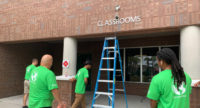The results of the 2008 National School Safety Study, which assessed the status of security in the nation’s K-12 public schools, based on a survey of school leaders nationwide, was released by Ingersoll Rand Security Technologies, Carmel, Ind., in conjunction with the American Association of School Administrators (AASA) and RETA Security Inc.
The study was based on the Risk Mitigation Assessment, a survey instrument created by Ingersoll Rand Security Technologies and RETA Security Inc. The assessment, which can be accessed at www.safeschools.ingersollrand.com, identified potential threats and determined action items to ensure the security of school systems. When the study queried school administrators about funding, approximately 80 percent of administrators describe their situation as “stretched” or “inadequate.”
While schools are doing a decent job overall, especially considering the budgets they have, there are other instances where much more needs to be done. For example, the study found that while two-thirds of all responding districts lock public entrances to buildings, one-third reported that exterior doors are occasionally or often propped open. Also, almost 60 percent of school buildings have no “panic” exit devices installed in strategic locations, a potential violation of the Fire and Life Safety Code.
“It is important for schools to place first priority on improving the areas of access control and communications,” said Paul Timm, president of RETA Security. “Demonstrating that there are low-cost, common-sense measures each school district can implement is a significant first step in providing a safer learning environment for students, staff, and visitors.”
“School leaders are dedicated to making sure students, teachers and staff are in the safest possible learning environments,” noted AASA Executive Director Daniel A. Domenech. “To that National School Safety Study end, we welcome the opportunity to use the data presented in this landmark study to ensure all schools have the best security resources available.”
“Ingersoll Rand Security Technologies undertook this initiative in keeping with our corporate stewardship responsibility,” explained Beverly Vigue, vice president of the company’s Education Solutions group. “This study shows the tremendous value in getting the most accurate pulse on trends in school security in order to remain at the forefront in developing truly effective solutions that keep learning environments safe and productive.”
As a follow-up to the study, AASA, Ingersoll Rand Security Technologies and RETA Security are discussing how to best leverage the results of this study to the advantage of America’s school communities. Grant tool kits are already on the www.safeschools.ingersollrand.com website. Plans include regional training initiatives, including common sense tips schools can implement to increase the safety of students at little to no cost. For example, school districts can organize school safety committees with broad-based stakeholder representation that meet regularly to review safety policies and needs.
“We are in a unique position to respond to schools,” stressed Vigue. “For instance, we have education specialist representatives located in 18 Security and Safety Consultant offices across the nation who can help schools with a host of products and services, including alternative funding programs such as our grant funding program to help them pay for improvements. Our customer grant consultants are also finding that funding is available from a variety of programs for those districts needing to migrate to more sophisticated, district-wide school security and safety systems.”
The full survey results are available on the AASA website at www.aasa.org.


